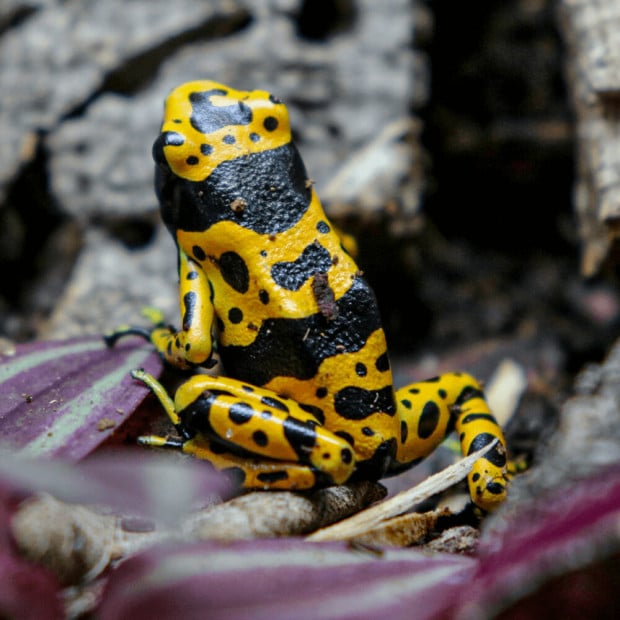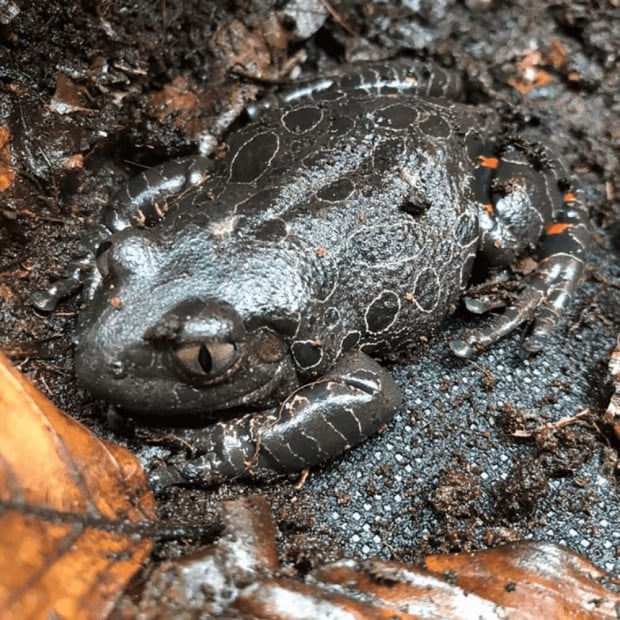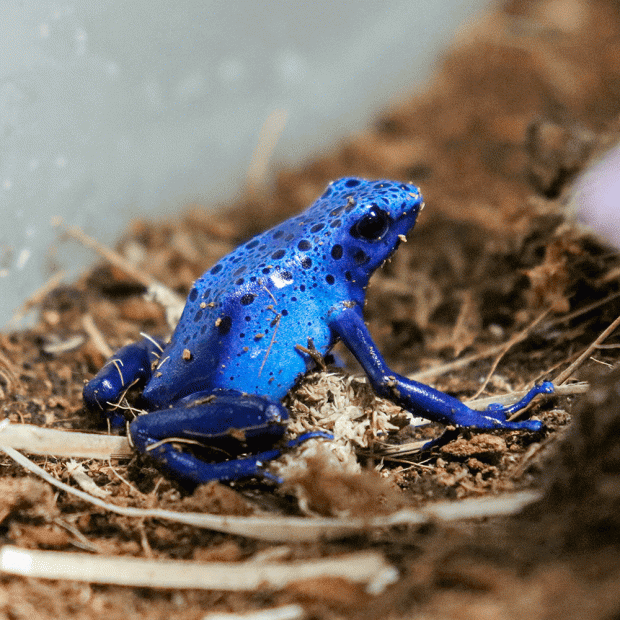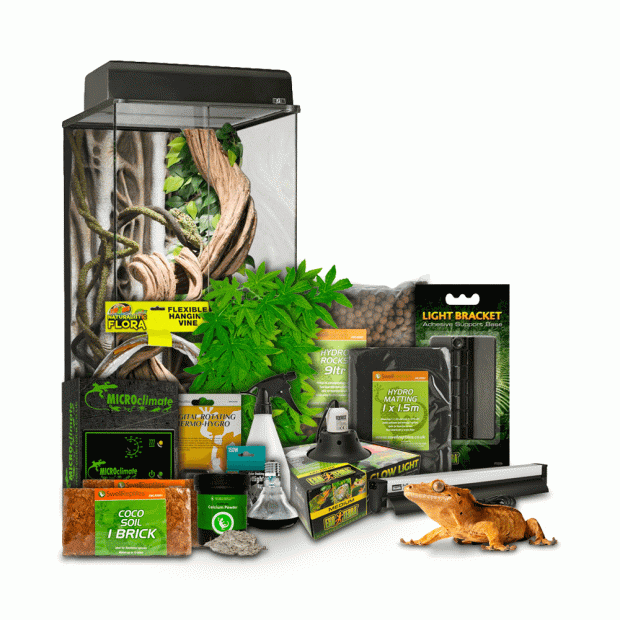- Amazon milk frogs are hardy and adorable frogs
- Easy care requirements so good for beginners
- Social frogs that are fun to keep as pets
Do Amazon milk frogs make good pets?
Amazon milk frogs are a large species of tree frog native to the Amazon rainforest in South America. They grow to around 6-10cm (2.5-4"), with females generally being larger, and are characterised by light grey-blue bodies with unique dark grey-black patterns and yellow eyes.
Amazon milk frogs are an arboreal species, named for the sticky white substance they excrete when threatened by predators. This species is very social, with individuals communicating through the use of vocalisations which are mostly heard during their crepuscular active hours - at dawn and dusk.
What type of enclosure do Amazon milk frogs need?
Amazon milk frogs are arboreal, so their enclosure should be vertically oriented to accommodate this. Due to the humid environment required to house this species, glass terrariums tend to work better than wooden vivariums, as they eliminate the risk of water damage to the enclosure.
Amazon milk frogs are a social species best kept in pairs or small groups. It is important to note the sex ratio of the group, however, and ensure that there are not too many males, as this is likely to cause breeding stress to the females in the group. It is also important to ensure individuals are of similar size to avoid cannibalism.
For a pair or small group, we recommend a minimum enclosure size of 45x45x90cm (18x18x36"), such as the Exo Terra Glass Terrarium 45x45x90cm. Alternatively, our range of Crested gecko starter kits would also be suitable for housing Amazon milk frogs.
Do Amazon milk frogs need to be heated?
Amazon milk frogs prefer a warm area temperature of around 26-28°C (78-82°F) and a cool end sitting closer to 22°C (71°F). In most homes, this can be achieved without much extra help, but you may need to provide a little supplementary heating in the form of a basking lamp or ceramic heater suspended above the enclosure. All heating equipment must be hooked up to a compatible thermostat, for basking lamps this would be a dimming thermostat, whereas for ceramic heaters this would be a pulse thermostat.
Do Amazon milk frogs need UVB light?
Research has shown that the presence of a low-level UVB light, providing a UVI between 1-2 is highly beneficial for Amazon milk frogs. The easiest way to achieve a UVI between 1-2 is using an Arcadia ShadeDweller ProT5 Kit, placed between 25-40cm (10-15”) from the basking zone. You may, however, be better using the Arcadia ProT5 Kit - Forest 6% if your light fixture needs to be higher.
How humid should an Amazon milk frog enclosure be?
The simplest way to maintain a high humidity is by using a loose moisture-retaining soil-based substrate such as coco soil. If you are going to add live plants to your enclosure, however, you may be better opting for a more sophisticated planting substrate such as ProRep Bio Life Forest or Arcadia EarthMix. It is also worth considering adding a layer of debris topping the substrate, which can consist of carpet or cushion moss and leaf litter, further aiding humidity levels.
Particularly if you choose to go bioactive, you will also need to add a drainage layer to prevent the soil from becoming waterlogged and protect the roots of your plants. This layer should be made up of a layer of Hydro rocks, topped with a sheet of Hydro matting before adding the substrate. This will also allow you to keep a water reservoir underneath the substrate, which will allow water back up into the substrate layer if it starts to dry out.
Adequate drainage and good substrate is unlikely to be enough to maintain humidity levels of 70-80% alone, so you will still need to add water into the enclosure regularly either by misting manually with a handheld spray bottle, or using an automated fogger or rain system, which are particularly useful if you are out of the house a lot for work for example.
How do I decorate an Amazon milk frog enclosure?
Due to the increased humidity required to keep Amazon milk frogs healthy, they are the perfect choice for diving into the world of bioactivity. The foundations for any bioactive set-up should be a drainage layer as described above.
Once you have the foundations in place you can begin planting, it is worth bearing in mind that due to the drops in humidity, the chosen plants need to be tolerant of this and should also grow in such a way that you will be providing lots of cover in the canopy, which makes hardy climbers such as Golden Pothos a great option.
If bioactive isn’t your cup of tea, your Frog will not mind too much, just ensure you still provide plenty of cover from artificial plants and climbing areas in the form of branches and vines.
What do Amazon milk frogs eat?
Amazon milk frogs are insectivorous and should be fed on a varied diet of different livefoods, such as crickets, locusts, calci worms and flies. All livefood must be dusted with supplements according to a schedule to ensure all of the required nutrients are provided in their diet.
We recommend using a calcium-rich multivitamin on every feed, such as Arcadia EarthPro-A, a calcium plus magnesium supplement on every fourth feed, such as Arcadia CalciumPro Mg and finally, a vitamin D3 supplement on every eighth feed such as Arcadia EarthPro RevitaliseD3 and finally, a vitamin a reptile supplement on every 12th feed, which is particularly important for most amphibians.
Can I handle my Amazon milk frog?
Handling of Amazon milk frogs should be avoided wherever possible. Amphibians are characterised by a semi-permeable skin membrane over which they absorb water and its contaminants. As human skin often has salts, oils and other substances present, it is not difficult to imagine that this can cause irritation to the sensitive skin of amphibians.
If handling cannot be avoided, for example when rehoming, this should be done using clean, damp hands or even gloves, and should be done as quickly as possible.
How do I buy an Amazon milk frog?
If you like the look of our UK captive-bred Amazon milk frogs, this will need to be collected from our physical superstore, so why not come in and see us. We will ask a few quick questions and also ask to see some images of a suitable set-up ready for the frog to go into. We reserve the right to refuse adoption to anyone we feel is unprepared to adopt.
| Common names | Amazon milk frog, Mission golden-eyed tree frog |
| Scientific name | Trachycephalus resinifictrix |
| Country | South America |
| Captive-bred | Yes |
| Adult size | 6-10cm (2.5-4") sex-dependent |
| Natural habitat | Rainforest habitats |
| Housing | 45x45x90cm (18x18x36”) |
| Ideal temperature | 28°C (82°F) (warm end); 22°C (71°F) (cool end) |
| UVI | 1-2 |
| Ideal humidity | 70-80% |
| Diet | Insectivorous |
| Average lifespan | 5-10 years |
| Personality | Bold |
| Ease of handling | Handling should be avoided |
| Cohabitable | Yes |
-
 Bumblebee dart frogs, Dendrobates leucomelasFrom £85.00In stock
Bumblebee dart frogs, Dendrobates leucomelasFrom £85.00In stock -
 Red leg running frogs, Phlyctimantis maculatusFrom £30.00In stock
Red leg running frogs, Phlyctimantis maculatusFrom £30.00In stock -
 Blue azureus dart frogs, Dendrobates tinctorius azureusFrom £90.00In stock
Blue azureus dart frogs, Dendrobates tinctorius azureusFrom £90.00In stock -
 Orange splashback dart frog, Adelphobates galactonotus 'orange'From £120.00In stock
Orange splashback dart frog, Adelphobates galactonotus 'orange'From £120.00In stock








